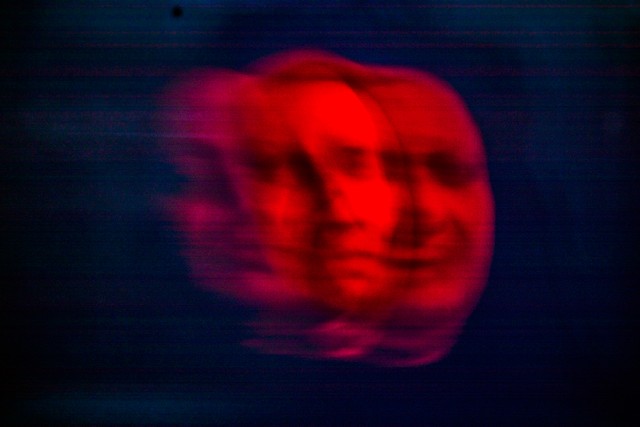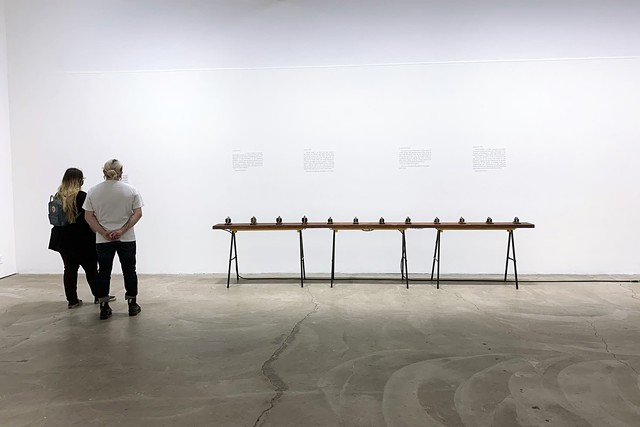Ghosts in the machines at RoCo’s ‘Messages & Mediums’ | Art
“Messages & Mediums,” the clearly show at this time at Rochester Modern Art Middle, couldn’t be more timely. Though the environment is nonetheless grappling with the consequences of COVID, the present presents the do the job of two artists who offer with crossing terrific divides: loss of life and actual physical distance.
The exhibit is deeply intelligent in its exploration of possibly the most profound concern of all: “Is there just about anything right after dying?”
On look at as a result of Saturday, Nov. 13, “Messages & Mediums” functions function by photographer Shannon Taggart and composer-sculptor Matthew Ostrowski, who each and every take a look at the intersection of fashionable spiritualism and engineering. Both equally installations nod to people today who have made a dwelling connecting the dwelling with the lifeless. But far more than that, these functions suspend disbelief in the exact way that technological advancements in interaction have expanded our knowing of what’s attainable.
Taggart’s pictures of psychic mediums capture her subjects in the midst of spirit-channeling trances.
“She’s not genuinely a journalist, dropping in to document a group,” says Rochester Modern day Government Director Bleu Stop. “She has their rely on.”
Taggart, who is based mostly in St. Paul, Minnesota, began photographing Spiritualist mediums in 2001, when she meant to invest only a several months at Lily Dale, the hamlet southwest of Buffalo that is house to the world’s greatest Spiritualist local community.
“But by the close of that very first summer, I couldn’t leave Lily Dale,” Taggart wrote in her artist statement. “I had turn into fascinated by the heritage and aesthetics of the religion by itself.”
Taggart generally employs extended exposure to seize the movement of the medium in the course of a seance, which in some cases final results in multiple, blurred faces, as even though an additional currently being is current in the vicinity of the medium.
In one particular of Taggart’s visuals, vapor billows from the mouth of medium Jack Munton, alluding to ectoplasm — a time period for non secular strength exuded by mediums very first coined in 1894.
Digital pixelation in the vapor in the graphic, and the captioned text “jack…” is captured in the body, belying the system (Skype) in excess of which Taggart documented the session.
Even though “Messages & Mediums” is wrapped all over timeless concerns, it’s also of-the-instant. Both artists make use of contemporary technology in their perform. Taggart’s use of virtual platforms to continue her image documentation of seances in the time of COVID mirrors the massive change our modes of interaction have had to get in the past two yrs.
“Again I took inspiration from the Spiritualists,” Taggart wrote. “They think that otherworldly interaction are not able to be bound by time or house. They have a tradition of experimenting with media, technology, and automated artwork to bridge the gap concerning this entire world and the future.”
The livelier aspect of the show arrives from New York City-based mostly artists Matthew Ostrowski’s installation, “Summerland.” The title draws from 19th century American Spiritualist Andrew Jackson Davis’s thought of an inhabitable sphere of spiritualized make a difference in space. The do the job “conjures” the lifeless voices of Samuel F. B. Morse, inventor of Morse Code and the earliest text-messaging equipment, the telegraph, and of Kate Fox, the youngest of the historic Rochester Spiritualist mediums, the Fox sisters.
The set up options a couple of extensive, slim tables, each individual with evenly-spaced telegraph receivers periodically tapping out messages. Prices from the writings of Morse and Fox are preset to the wall above each and every device, translating the taps for guests.
Of class, the common denominator concerning Morse and Fox is tapping. The Fox sisters’ infamous system of channeling the useless was by way of tapping on the underside of a desk Morse’s invention transmitted messages over wonderful distances as a result of tapping that travelled along a wire from an digital transmitter to a receiver.
It’s loud, unpredictable, and more than a person member of RoCo’s workers joked about the maddening facet of functioning below the tyranny of the temperamental set up.
Aggressive, staccato taps invade the tranquil peace of the house the exact same way the shrill ring of a cell phone can upset silence — voices from elsewhere interrupting us heading about our business enterprise.
https://www.youtube.com/view?v=yBcYE4Yosf8
And nevertheless Ostrowski’s set up employs 19th century telegraph technological know-how, he wrote laptop algorithms that pilot the tapped-out messages.
It is well worth noting that Morse was a portrait painter, right until the fateful 12 months when he was out of town working on a commission and his wife turned gravely sick. The concept of her ailment, carried by horseback courier, took so long to achieve him that he not only arrived dwelling soon after she died, but she was already buried. In his grief, he introduced his secondary job, inventor, to the fore, and served develop know-how that would pace up lengthy distance communication by leaps and bounds.
In his artist statement, Ostrowski wrote: “While Morse saw his invention as unifying the entire world by means of rationalized know-how, the invisible nature of electric forces stirred good desire in the prospective existence of other forces which might offer you means of communicating with departed spirits.”
Rebecca Rafferty is CITY’s lifestyle editor. She can be attained at [email protected].









 

 